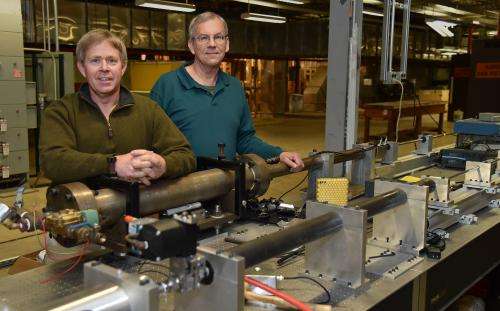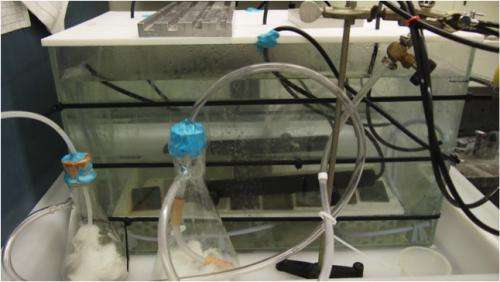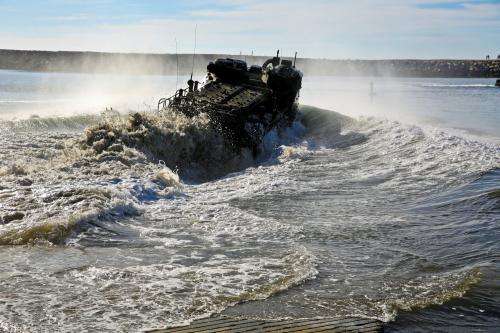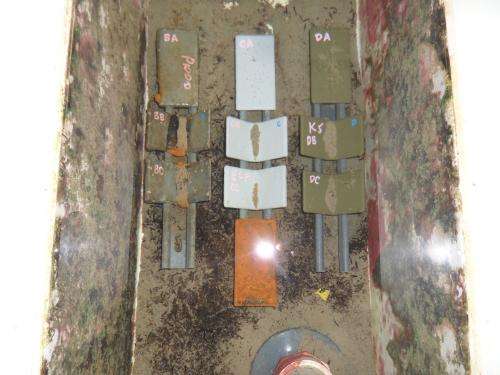Rubber research may extend life of amphibious assault vehicle

The U.S. Naval Research Laboratory (NRL) has found that some types of rubber provide corrosion protection—and potentially better ballistic protection—for amphibious assault vehicles (AAVs). This is important to the U.S. Marine Corps (USMC) as they look to extend the AAV, introduced in 1972, through 2035. "Innovative sustainment concepts, like those NRL is investigating, enable us to avoid the cost of new design, development, and production of new components," says Tim Bergland of the USMC Advanced Amphibious Assault (AAA) office.
Dr. Mike Roland and Dr. Ray Gamache led the research for NRL. "What makes [AAVs] unique is they can go in water and land," says Roland. "They give the Marine Corps a capability that no other service has."
Since the 1990s, the U.S. Marine Corps (USMC) has been bolting armor onto their AAVs. "The armor itself is a laminate of high hard steel, which by itself is good for ballistics; a rubber layer; then there's another soft steel layer in the back," says Roland. The problem is that the armor gets corroded with intense use and exposure to salt water.
Roland and Gamache found rust and corrosion start at cracks in the paint. "You've got steel, rubber, steel—and these things are thermally expanding and contracting differently," says Roland. "In addition to which, AAVs aren't driven like expensive Volvos; they're banging into stuff—and now you've got a way for water ingress."
NRL showed that certain types of rubber, called polyureas, could better protect the armor from corrosion by stretching with it, instead of cracking like brittle paint.
They also showed polyurea coatings slow bullets and blast fragments. "They take kinetic energy from the bullet," says Roland. "So the bullet, to keep penetrating, it's meeting an increasingly resistant medium. And if it slows down enough—it always makes it to the steel plate, but it doesn't have enough velocity to get through it."
NRL's research could help extend the life of today's AAVs, and may also guide the next generation of ship to shore connectors. "We solved the corrosion problem," says Roland. "And with a negligible increase in weight, we also provided a higher payload capacity and the potential for better ballistic protection."
Corrosion protection: polyurea coatings don't crack like paint
By exposing steel test pieces to saltwater in their lab, Roland and Gamache also showed polyurea protects armor from corrosion much better than paint.

"We wanted to simulate what happens in the field, so we bent some of the test pieces," says Roland. In addition to flat test pieces, "we had a gentle bend and we had a 90° acute bend." They tested five coatings: two types of paint, a polyurea NRL's been using in other armor applications, and two polyureas developed by a private company. "We set up aquarium tanks filled with sea water. We raised the temperature to 40 and 50 centigrade [104 and 122°F], just to accelerate the corrosion, and we bubbled air so there was plenty of oxygen."
The polyurea worked much better than paint. "If you just put the plate in flat, they'll all work," says Roland. But with the bent pieces, "the paints tend to crack. The polyureas don't because they're elastomeric, rubbery; so they stretch and don't open up a pathway for the water."
While having a long-term solution is very important, the USMC also needs to know how best to maintain the AAVs in use now. "We quantified how much they're going to lose, in ballistic performance, with the corrosion," says Roland. "This will guide the Marine Corps in when they need to replace or repair the armor, saving a lot of money."

NRL continues to monitor samples in actual seawater troughs at NRL's Key West facility. "The ones that performed the best in salt water tanks in the lab are performing best at Key West," says Roland.
"The best of both worlds": how is polyurea stretchy and so tough?
Polyureas aren't as common as conventional rubbers; but if you've seen a pickup truck bed-liner, you've seen a polyurea. Conventional rubbers, polyurethanes, are isocyanate covalently reacted with an alcohol. "But if you react [isocyanate] with an amine, you get urea," says Roland. "Polyurea is better because it's got a lot more hydrogen bonding."

The hydrogen bonds are weak, compared to covalent bonds, so they break first. "That'll alleviate stress," says Roland, "and maybe your covalent bonds, the polymer chains themselves, remain intact. And the beauty of the hydrogen bonds is they'll reform; so when you remove the load, you don't have any permanent damage." That makes it multi-hit capable.
"In conventional materials, you can have something that's really stiff but doesn't stretch much; or you can have something really soft, like silly putty, and it stretches a lot," says Roland. "Polyureas, they can stretch to 10 times their original length, but the force it takes to do that is enormous—so you get toughness, the best of both worlds."
Provided by Naval Research Laboratory



















